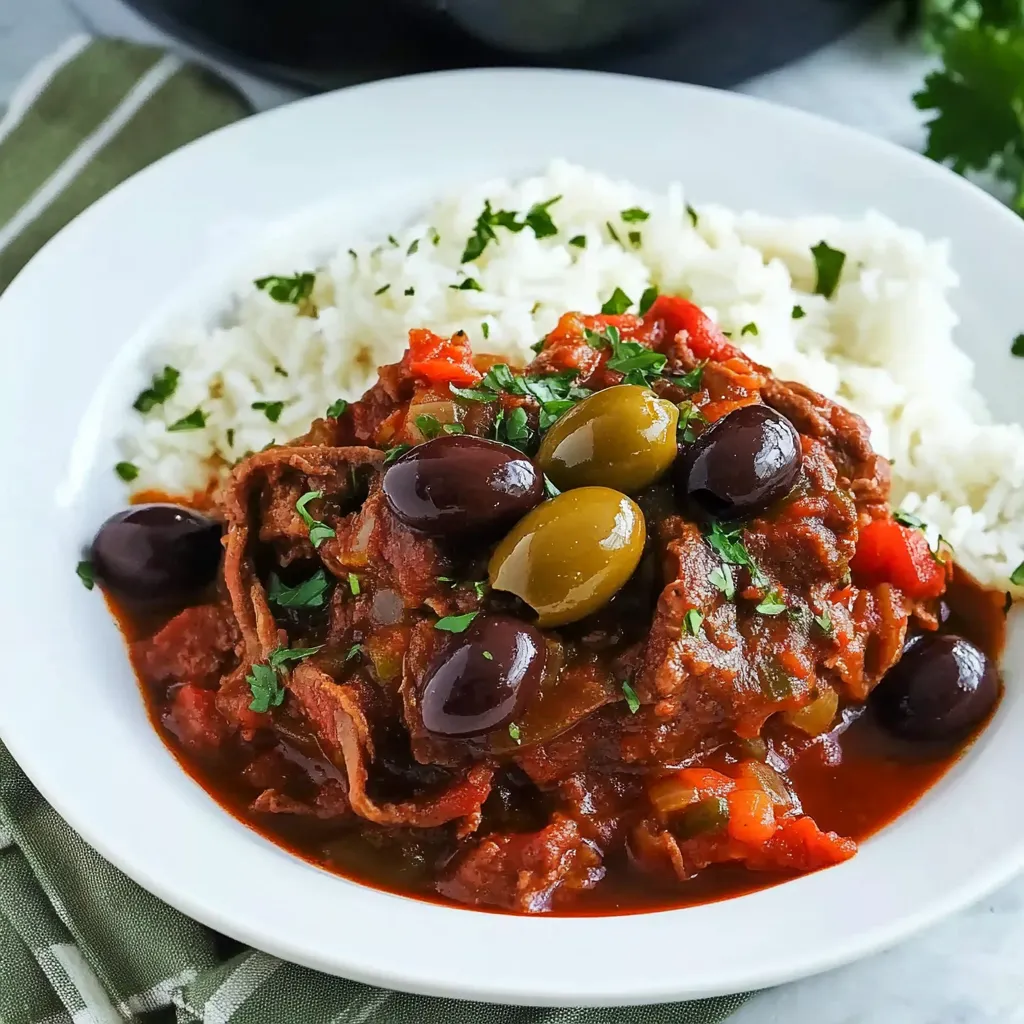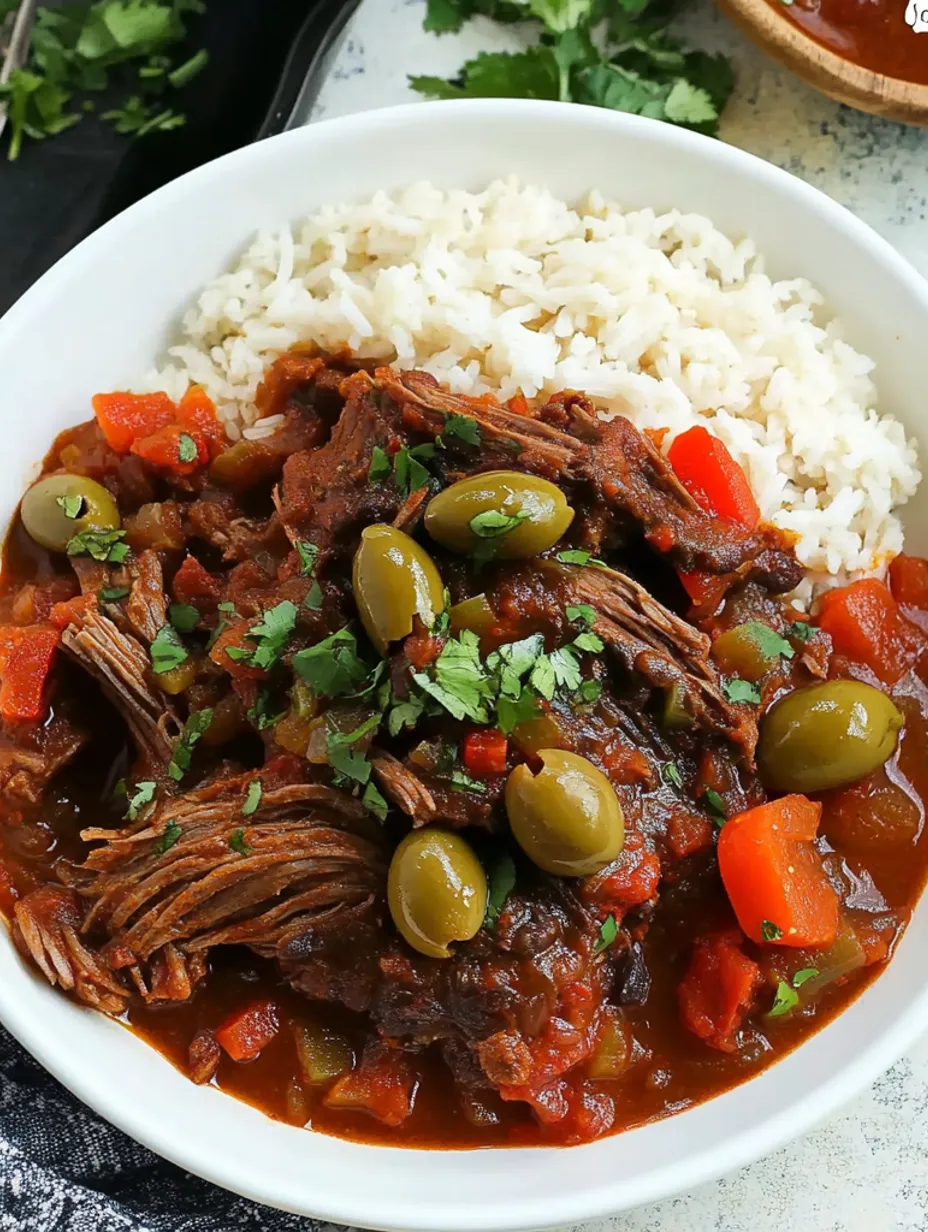 Pin it
Pin it
This hearty Cuban Ropa Vieja has become my weekend cooking ritual, filling my home with aromas that transport us straight to Havana. The dish's name translates to "old clothes," referring to the shredded beef that resembles tattered fabric, but the flavors are anything but worn out.
I first made this Ropa Vieja for friends who had recently returned from Cuba and were missing the cuisine. Their eyes lit up with the first bite, confirming I had captured the authentic flavors they were craving.
Ingredients
- Chuck roast: the perfect cut for slow cooking as its marbling breaks down creating meltingly tender shreds
- Yellow onion and bell peppers: create the aromatic sofrito base that defines Cuban cuisine
- Garlic: adds essential pungent notes that bloom in the hot oil
- Cumin, smoked paprika, sweet paprika, oregano, and allspice: create the authentic Cuban spice profile
- White wine: deglazes the pan capturing all the browned bits of flavor
- Chicken stock: adds richness without overpowering the beef flavor
- Crushed tomatoes and tomato paste: provide the tangy base for the sauce
- Carrot and celery: add subtle sweetness and depth during cooking
- Green olives, capers, and pimentos: bring briny brightness that cuts through the richness
Step-by-Step Instructions
- Prepare the meat:
- Trim any large fat sections from the chuck roast and season generously with kosher salt and fresh black pepper on both sides. This initial seasoning layer is crucial for developing depth in the final dish.
- Sear the beef:
- Heat vegetable oil in a Dutch oven over medium-high heat until shimmering. Place the seasoned roast in the hot oil and let it brown undisturbed for about 4-5 minutes per side until a deep mahogany crust forms. This caramelization creates rich flavor compounds that will infuse the entire dish.
- Develop the sofrito:
- Add sliced onions and bell peppers to the same pot where you seared the beef. Cook them slowly until the onions become translucent with golden edges and the peppers soften completely. This should take about 8-10 minutes and forms the flavor foundation of the dish.
- Bloom the spices:
- Reduce the heat to low before adding the garlic and spice mixture. Stir continuously for exactly one minute to toast the spices without burning them. You'll know they're ready when the aroma fills your kitchen with warm fragrance.
- Build the braising liquid:
- Pour in white wine and bring to a boil while scraping the pot bottom vigorously with a wooden spoon. This deglazing step incorporates all the flavorful browned bits into your sauce. Add chicken broth, crushed tomatoes, tomato paste, and aromatics then return the beef to the pot.
- Slow cook to perfection:
- Cover and simmer gently for 2½-3 hours until the meat yields easily when pierced with a fork. The low slow cooking breaks down tough muscle fibers and connective tissue resulting in extraordinarily tender meat.
- Shred and finish:
- Remove the beef to a cutting board and shred using two forks pulling along the natural grain of the meat. Discard the spent aromatics from the sauce then return the shredded beef to the pot. Add olives, capers, and pimentos then warm through gently to preserve their bright flavors.
 Pin it
Pin it
My grandmother always insisted on adding a splash of vinegar right at the end of cooking. She claimed it brightened all the flavors and was her secret touch. I continue this tradition with a tablespoon of red wine vinegar just before serving in her memory.
The Dutch Oven Advantage
Using a Dutch oven for this recipe provides superior heat distribution compared to regular pots. The heavy cast iron maintains consistent temperature and allows for a transfer from stovetop to oven. The oven method at 350°F creates a gentler all-around heat that breaks down the tough meat fibers more effectively than stovetop simmering. The result is unparalleled tenderness without the risk of scorching the bottom of your sauce.
 Pin it
Pin it
Serving Suggestions
Traditional Cuban accompaniments elevate this dish to a complete meal. Serve your Ropa Vieja over white rice which soaks up the flavorful sauce perfectly. Black beans cooked with a bay leaf and a hint of cumin make an authentic side. Fried plantains add a sweet contrast to the savory meat. For a full experience include a simple avocado salad dressed with lime juice and a pitcher of mojitos for the adults at your table.
Cultural Context
Ropa Vieja originated during Spanish colonization of Cuba but transformed with local ingredients and techniques. The dish represents Cuban resourcefulness during times of scarcity. Legend tells of a poor man who couldn't feed his family so he cooked his old clothes which miraculously transformed into a delicious beef stew. Beyond Cuba this dish appears throughout the Caribbean with regional variations reflecting local preferences and available ingredients. In Puerto Rico it often includes potatoes while Dominican versions might incorporate more local herbs.
Storage And Reheating
Refrigerate leftovers promptly in airtight containers where they will keep beautifully for up to 4 days. The flavors actually intensify and meld together making day-two Ropa Vieja even more delicious than freshly made. For reheating gentle heat is key. Warm portions in a covered skillet over medium-low heat adding a tablespoon of water if the sauce seems too thick. This prevents the meat from toughening and preserves the texture better than aggressive microwave reheating.
Frequently Asked Questions
- → What cut of beef works best for this dish?
Chuck roast is the ideal cut for its marbling and tenderness when slow-cooked. It pulls apart easily for shredding.
- → How can I enhance the flavors of the dish?
To deepen the flavor, use freshly ground spices and let the dish simmer on low for the full recommended time.
- → Can I make this dish in advance?
Yes, Ropa Vieja tastes even better the next day as the flavors meld. Store it in an airtight container in the fridge.
- → What can I serve alongside this dish?
Traditionally, Ropa Vieja pairs well with white rice, black beans, and fried plantains for a complete Cuban meal.
- → How do I store and reheat leftovers?
Store leftovers in the fridge for up to 4 days or freeze for 3 months. Reheat on the stovetop or microwave at reduced power.
